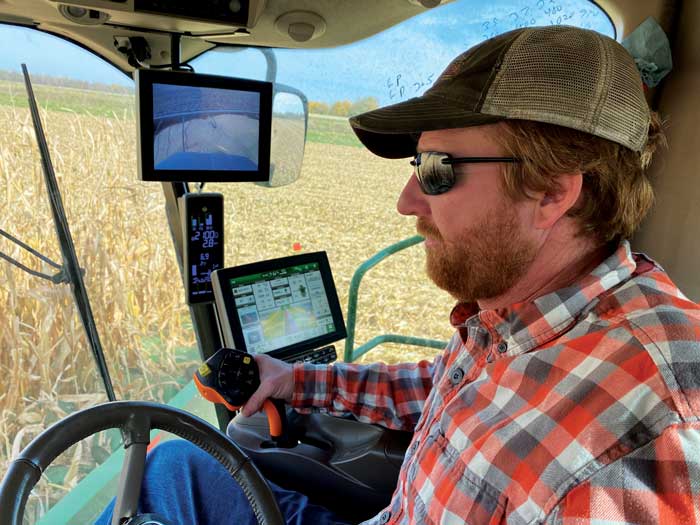Fourth-generation farmer Jay Riddell strip-tills corn and soybeans across 2,500 acres in Sparland, Ill. Strip-Till Farmer paid him a visit as he wrapped up corn harvest on an unseasonably warm day in late October. Riddell welcomed us inside the cab of his new John Deere S780 combine for a conversation about his strip-till system, including his unique approach to soybean planting, management zones and cover crops.
How long have you been strip-tilling?
Jay Riddell: We started in 2007. Before we had auto-guidance, it was hard to stay on the strip and make it work. We’re 100% strip-till now, which isn’t very common in this area. There are probably only 3 other strip-tillers within 25 miles of here.
What’s your crop rotation?
We’re not on a straight 50/50 rotation. Some fields are corn-corn-soybean, and others are just corn-soybean. We strip-till both corn and soybeans, which is different. Around here, most strip-tillers are no-tilling soybeans. I also like to plant soybeans before corn by mid-April at the latest. Then we’ll get started on corn as soon as the conditions are right.
Why do you strip-till soybeans?
80-plus-bushels-per-acre soybeans require a decent amount of fertilizer that I need to band right where it is needed. The strips >are also warmer and drier than no-till, which aids in early planting.
What’s your motivation for planting soybeans earlier than corn?
The agronomics. Soybeans need to canopy in 30-inch rows in my strips, so we need to catch all the sunlight we can. Planting them earlier is the best way to do that. Soybeans are much tougher than corn — we can afford to plant them in marginally cold conditions.
When do you build your strips?
We build them mostly in the fall. We do have some cows that run on corn stalks, so we’ll strip those fields in the spring.
What role do management zones play in your operation?
Everything we do is based off management zones. With our zones, the goal isn’t to reduce fertilizer or input costs, but to reallocate it. I want my cost per bushel through all areas of the field to be the same. We want to spend the most money where we think we’ll have the greatest return. An area that we think can yield 300 bushels per acre will get more fertility and more seed. In other areas, around tree lines for example, we’ll cut back on inputs.
We’ve found that in the poorer areas, when we reduce inputs, we actually end up increasing the production. We were planting corn too thick before, and that soil couldn’t produce at a higher population. When we cut back the population to 26,000-28,000, it was growing more than when we tried to plant it at 34,000.
How do you develop your management zones?
I have an agronomist who helps me set them up. We used to run a Veris Technologies soil sensing machine, but now we switched to SoilOptix. We run that over every acre, which determines exactly what soil types are where. We assign every field a yield goal and make decisions based on that. We could have areas of the field that produce 80% of the yield goal and others that produce 120%. We ultimately end up with a map of a management zone that adds up to 100% of the yield goal, and that’s how we determine where we’re applying the most inputs within the zone.
The yield maps are like our report cards. We’ll leave checks with the standard practice that tells us if our management zones were accurate, improved or hurt us. Ultimately Mother Nature has the trump card. All we’re really doing is trying to set ourselves up for success in a normal year.
Let’s talk about your nutrient management plan. How do you apply fertilizer?
We blow dry fertilizer in the strip about 7 inches deep. I’ve got a 16-row Nifty Ag strip-till bar that has two 6-ton compartments on it. Potash is in one compartment, and we mix monoammonium phosphate (MAP) and sulfur together in the other compartment. We blend the products together and apply at variable rates as we go across the field. The bulk of our nitrogen (N) is applied with anhydrous during sidedress time.

IN THE CAB. Sparland, Ill., strip-tiller, Jay Riddell wraps up corn harvest on his new John Deere S780 combine. Riddell controls and steers the auger cart from the cab.
When do you sidedress?
It depends on the year, but usually around June. We won’t make our prescription map until 48 hours before we put it on because we want to make sure we’re getting the most bang for our buck. Sometimes we might cut back rates if corn prices are low or N prices are high. This year we pushed the rates higher because we had such a beautiful stand. That’s the beauty of in-season application. It’s better for the environment but also allows us to call an audible and give the field what we think it needs for that particular year.
So no anhydrous in the fall?
We don’t apply much anhydrous in the fall. We might on small fields that are hard to sidedress. We also do a good amount of custom work, and most of our customers want anhydrous applied in the fall.
You already mentioned your Nifty Ag strip-till bar — what other equipment are you using?
The bar is pulled by a Fendt 1050 520 hp tractor. We have a John Deere 1770 planter with all the precision toys on it — hydraulic downforce, vSet meters, SpeedTubes — and it’s pulled by a Deere 8345R tractor. Our combine has a 16-row corn head and 40-foot draper.
Do you use cover crops?
We’re 100% cereal rye ahead of soybeans. But that’s the only thing we don’t do ourselves. A guy comes in right behind us after harvest and drills in cereal rye at a rate of 30-35 pounds per acre on fields going to soybeans. We strip the field after the rye has germinated. In the spring, I can’t see our strips from the road — I just see the rye. But the planter with auto-guidance finds those strips.
What are some of the biggest benefits from cereal rye?
Building organic matter, erosion control and weed suppression. What was an expensive first chemical pass now becomes a cheaper chemical pass because it’s nothing but a burndown. The rye does a good job suppressing all the early weeds. We save enough on the first chemical pass to pay for the cereal rye, and everything is a bonus from there. We plant green and terminate within 48 hours with our John Deere 4930 self-propelled 120-foot boom sprayer. It has the Raven Hawkeye nozzle control system on it. It’s a real nice, efficient machine for spraying around waterways.
What’s something you know now that you wish you knew when you first started strip-tilling?
I didn’t realize in the beginning how it was going to be a constant work in progress. There’s always something better we can be doing to help the situation. Just be fluid with it, keep evolving, and try to improve every year.
What’s the main goal or motivation behind all your conservation practices?
We definitely want to be good stewards of the land and leave it better than we got it. By the same token, we’ve got to be profitable. We’re always watching our bottom line with everything we do.







